'Round the Table' Family Catechesis
Good Shepherd, Psalm 23 (1a, b, c, d)
AIMS:
- To understand from the characteristics of the sheep what is shepherd’s care all about.
- To understand how much shepherd loves the sheep and cares for them so children can subconsciously begin the process of opening to the infinity of the Good Shepherd’s love.






























Ask children to draw about how much the shepherd loves sheep and how much he cares for them.
Ask children to tell about what they have drawn: „Tell me something about what you have drawn”. Please write child’s comments on the bottom of the drawing.
Prayer:
We light the candle and read Psalm 23, after a moment of silence we thank God:
„Thank you Lord for our daily bread”
„Thank you Lord for our parents, who work so we can have food to eat”
„Thank you Lord for all the people, who work to produce food: farmers, butchers, drivers, shop keepers, cleaners, shop-builders, cooks, parents”
„Let’s pray for those who have nothing to eat”
„Thank you Lord that we are well”
„Thank you Lord that for doctors, nursesand parents, who care for us when we are sick”
„Thank you Lord that you are with us always, especiallyin the very difficult situations, we do not need to be afraid”
„Thank you Lord.....”
SUBJECT: Parable of the Good Shepherd and Parable of the Lost Sheep
Parable of the Good Shepherd
AIMS:
- To introduce the parable through which Jesus reveals to us the mystery about himself and His relationship with us.
- God comes to us through Jesus, offering a love that is personal and communal.
- God’s love is unconditional.
- Jesus who knows and calls each sheep by name initiates relationship. He gives to/for sheep his life. It is a relationship based on
- His total self-giving to us,
- our listening to His voice and
- our free will to respond to His call
- To present visually communion (relationship of self-giving) and sin.
- Jesus provides a safe and secure place for us and we can trust him
- Before we present the materials to children we need to remind them about the respect we show to the Gospel. During the Mass we stand up to listen to the Gospel. The materials are not just toys; they are the Gospel story made visible. So we need to handle them with respect, the way we would handle the Bible.
- The materials should help children to listen with their heart; they should help in building the relationship with God. We try to use the words and phrases from the Bible. We should also be careful how we move the figures. It seems natural to move a few sheep at once. However, it is important to move sheep one by one. These movements are very important for children.
- After we present material a few times, when the children memorize the key phrases and learn to move the figures with respect, we can let them work with materials on their own.
- We never tell children that we are the sheep, because we would take away from them the joy of discovering it on their own. Sometimes the child will understand immediately that we are the sheep. We should continue by getting back to the detail of the parable and by giving more questions we should try entering deeper into reflection to reach children’s heart.
- We invite children to reflect and respond through art. The time spend while drawing is a time for reflection; time for a relationship of God and child. When children finish drawing, we may ask “Can you tell me something about your drawing?” and write children’s response on the drawing.
MATERIALS:
The materials need to be presented in the three separate sessions. Each session consists of:
a. Telling the story in your own words
b. Presenting materials
c. Reading verses from the Bible
d. Asking questions, meditating together
e. Thanksgiving prayer
f. Reflection time - responding to the Word of God through drawing
SESSION ONE:
a. Two thousand years ago there was someone who was saying things that nobody said before. People followed him and listened to him. They asked him many times “Who are you?”. He answered that he is the light of the world, and who follows him will have the light of life. Other time he said that he is the True Vine. One time he said that he is a Good Shepherd. I suppose he underlined that he is not just ordinary shepherd but a Good Shepherd. Good Shepherd knows each sheep by name and he calls them; they know his voice and they follow him.

b. In the time of Jesus shepherds were very poor. They had no money and no tools to build the sheepfold out of lumber. So they used boulders and rocks lying in the fields. Again they had no tools to make the gate so they slept at night laying in the opening to protect the sheep.
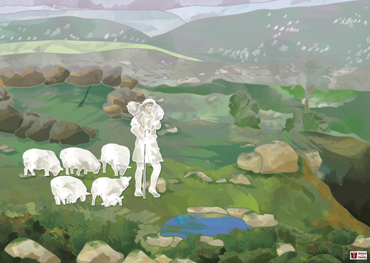
The Good Shepherd calls each sheep by name and they follow because they know his voice. He brings them to the green pastures. And then:
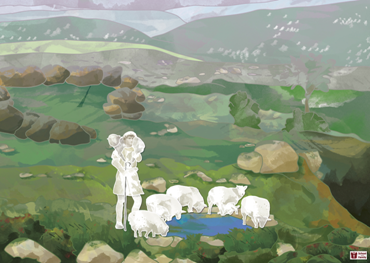
He brings them to the still water; he calls each one by name and they follow because they know his voice.
At the end of the day, when sheep had enough to eat and to drink he brings them back to the sheepfold so sheep can be safe at night. And again he calls each one by name and they follow because they know his voice.
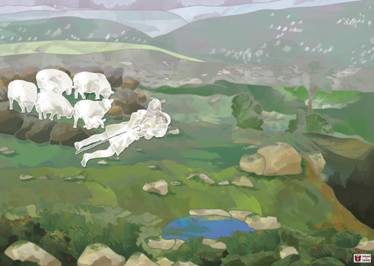
c. We can light the candle and read the verses from the Bible:
The Good Shepherd
3b The Good Shepherd one by one he calls his own sheep and leads them out. 4 When he has brought out all those that are his, he goes ahead of them, and the sheep follow because they know his voice.
5 They will never follow a stranger, but will run away from him because they do not recognise the voice of strangers.
10b I have come so that they may have life and have it to the full.
11 I am the good shepherd: the good shepherd lays down his life for his sheep.
14 I am the good shepherd; I know my own and my own know me, 15 just as the Father knows me and I know the Father; and I lay down my life for my sheep.
16 And there are other sheep I have that are not of this fold, and I must lead these too. They too will listen to my voice, and there will be only one flock, one shepherd. (John 10)
d. I wonder how do sheep feel… having enough to eat and enough to drink?
How do they learn to know shepherd’s voice?
I wonder what it means that the good shepherd lays his life for his sheep? Is there are anybody that lays down his/her life for you? I know two people in my life that lay down their life for me; they are an unconditional gift to me…
He must have a lot of sheep…how come he knows each sheep by name?
I wonder what it means to have life to the full?
e. Lord, we thank you for having home,
We thank you that mom and dad have work so we have our daily bread,
We thank you for living in the peaceful country,
Good shepherd, we thank you for caring for us and guiding us,
Lord Jesus, thank you for giving yourself unconditionally to us,
We thank you for…
f. We ask children to draw quietly in response to what they have heard.
SESSION TWO:
Place three “dark places, with no light in them” on the green felt.
a/b. The Good Shepherd calls each sheep by name and they follow because they know his voice.
He brings them to the green pastures.
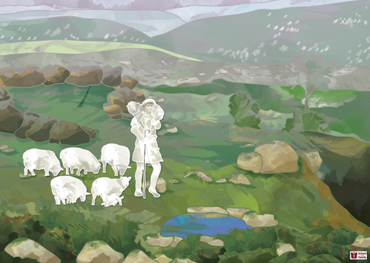
He brings them to the still water; he calls each one by name and they follow because they know his voice. While moving sheep from the pasture to the still water, leave one sheep in the “dark place”.
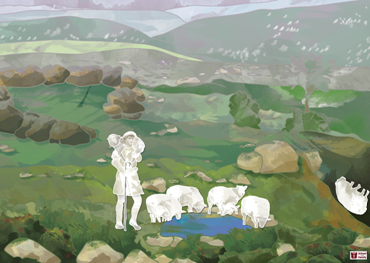
At the end of the day, when sheep had enough to eat and to drink he brings them back to the sheepfold so sheep can be safe at night. And again he calls each one by name and they follow because they know his voice.
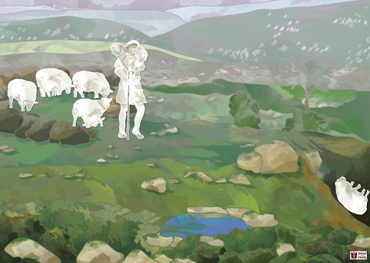
He counts his sheep and when he discovers that there is ninety-nine and one is missing he goes back to look for her.
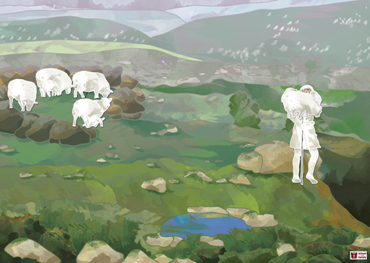
Even though is very late and he is very tired he keeps calling the one that is missing until eventually she hears his voice. He picks her up and holds her on his shoulders. They don’t feel any more as they are separate; they feel like one.
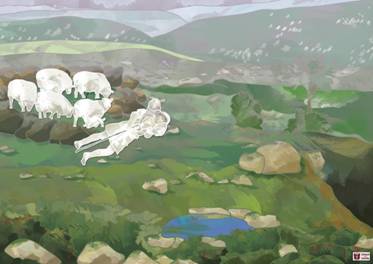
He brings her back to the sheepfold and all the sheep rejoice because the one who got lost was found.
c. We can light the candle and read the verses from the Bible:
The Lost Sheep
4 'Which one of you with a hundred sheep, if he lost one, would fail to leave the ninety-nine in the desert and go after the missing one till he found it?
5 And when he found it, would he not joyfully take it on his shoulders 6 and then, when he got home, call together his friends and neighbours, saying to them, "Rejoice with me, I have found my sheep that was lost." (Luke 15)
d. It must be so difficult to hear the Good Shepherd’s voice…there is so much noise, so many voices…I wonder how come that she got lost?
How did she feel, all alone, far from the shepherd?
How did the other sheep feel when they discovered that their friend is lost? They must have wondered what happened to her? Is she safe?
How did the Good Shepherd feel when he discovered that one sheep is missing?
How did he feel when she responded to His calling?
What was other sheep response, when the shepherd brought the sheep He found, back to the sheepfold?
e. Lord we thank you for our family, for people who care,
Thank you for having each other,
Thank you for loving us and looking after us.
f. We ask children to draw quietly in response to what they have heard.
- You can see that we do not present the parable of the found sheep from a moral point of view. (We will do it in April during preparation to the First Reconciliation). In our telling, the children hear and receive its message as another instance of the Good Shepherd’s boundless love for them.
SESSION THREE:
a/b. Sometimes sheep follows a very similar voice, the voice of the hired hand that does not care for the sheep.
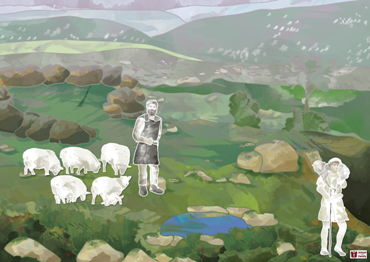
If the wolf comes,
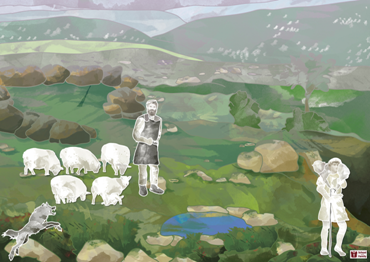
the hired man runs away because he cares only about himself.
The wolf snatches them and scatters them.
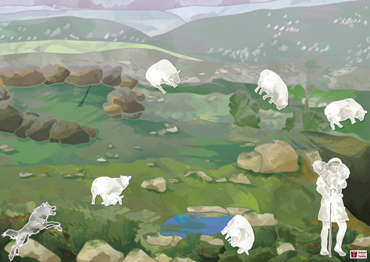
The Good Shepherd stands between the wolf and the sheep.
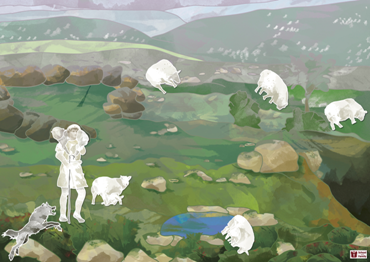
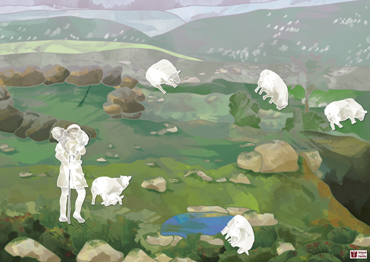
The Good Shepherd gives his life for the sheep.
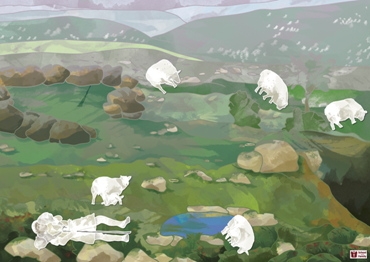
But he is not just ordinary shepherd; he is the Good Shepherd. He is risen in three days. And again he calls each sheep by name, and they follow him, because they know his voice.
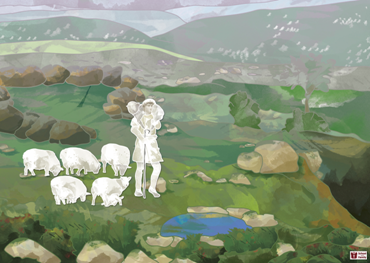
c. We can light the candle and read the verses from the Bible:
The Good Shepherd
12 The hired man, since he is not the shepherd and the sheep do not belong to him, abandons the sheep as soon as he sees a wolf coming, and runs away, and then the wolf attacks and scatters the sheep; 13 he runs away because he is only a hired man and has no concern for the sheep. 14 I am the good shepherd; I know my own and my own know me, 15 just as the Father knows me and I know the Father; and I lay down my life for my sheep.
16 And there are other sheep I have that are not of this fold, and I must lead these too. They too will listen to my voice, and there will be only one flock, one shepherd. (John 10)
d. I wonder how did the shepherd feel when the sheep followed the hired hand voice, not his?
How did the sheep feel when the hired hand ran away and the wolf attacked and scattered the sheep? Each one of them separated, far apart, away from each other…
I wonder who is stronger the wolf or the Good Shepherd?
e. Lord we thank you for protecting us from the wolf…
We thank you for giving your life for us…
Thank you for gathering us to one flock…
Thank you for caring for us and guiding us…
f. We ask children to draw quietly in response to what they have heard.
Conversation with Parents
(The following information is FOR PARENTS ONLY. This teaching can be shared with children in the future, NOT NOW)
AIMS:
Our relationship with the Good Shepherd is based on listening.
Our conscience is a place of God’s dwelling within us; in it’s depth his voice echoes. ”When he listens to his conscience, the prudent man can hear God speaking”. (CCC 1777)
Our conscience becomes blinded when our relationship with God is broken. (CCC1791)
Bible is the living voice of God. "SACRED SCRIPTURE is the speech of God as it is put down in writing under the breath of the Holy Spirit. And [Holy] TRADITION transmits in its entirety the Word of God, which has been entrusted to the apostles by Christ the Lord and the Holy Spirit. It transmits it to the successors of the apostles so that, enlightened by the Spirit of truth, they may faithfully preserve, expound and spread it abroad by their preaching" (CCC 81).
Bishops in communion with the successor of Peter, the Bishop of Rome are entrusted with a task of giving an authentic interpretation of the Word of God (CCC 85).
God speaks to us through people who care, priests, parents…
Earthly values like wealth, fame and knowledge can become the “hired hand”.
Hired hand could be also “my will” not “God’s will”.
The Church teaches that evil exists, but God has conquered it through the death and resurrection of Jesus Christ (CCC 409, 421)
QUESTIONS:
What is our relationship with the Good Shepherd based on?
What is the Good Shepherd’s voice in our daily life?
How come that we do wrong and some people even kill with the “clear conscience”?
Hired hand might represent our crooked conscience.
What else is the voice of the Good Shepherd in our daily life?
Did Jesus write anything himself? Did he “drop” the book when He ascended to heaven? What did he leave?
In what other way God speaks to us?
What else can be represented by the hired hand?
We all have no doubt what the wolf represents. We will not give much attention to it, but we must be aware of its existence. The biggest achievement of evil is that people stopped believing that it exists.

 English
English  Polski
Polski